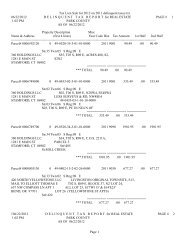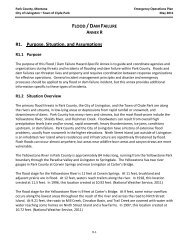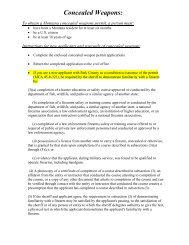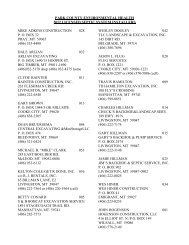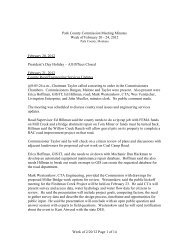Hantavirus Information - Park County
Hantavirus Information - Park County
Hantavirus Information - Park County
You also want an ePaper? Increase the reach of your titles
YUMPU automatically turns print PDFs into web optimized ePapers that Google loves.
<strong>Hantavirus</strong>: What is it?<br />
What can be done about it?<br />
compiled by Michael Vogel, MSU Extension Housing Specialist,<br />
and Jim Knight, MSU Extension Wildlife Specialist<br />
MT199404HR reprinted 5/04<br />
formerly MT199404AG<br />
<strong>Hantavirus</strong> is a serious cardiopulmonary infection that can cause death.<br />
The virus that causes the disease is transmitted to humans by such<br />
rodents as deer mice, which are common in Montana. This publication<br />
tells what hantavirus is and how it can be prevented.<br />
N O T E<br />
<strong>Hantavirus</strong> is a serious disease<br />
and steps should be taken to avoid<br />
exposure to it. However, hantavirus<br />
is a rare disease that results in fewer<br />
deaths than lightning strikes or<br />
snakebite or slip-and-falls on ice.<br />
<strong>Hantavirus</strong> in the US<br />
<strong>Hantavirus</strong> pulmonary syndrome<br />
(HPS for short), an acute and often<br />
fatal infectious respiratory disease<br />
endemic to North and South America,<br />
has lately become a serious concern in<br />
Montana and across the United States.<br />
In this country, hantavirus was<br />
first recognized during the spring<br />
of 1993 after a cluster of previously<br />
healthy individuals who lived in the<br />
Four Corners area of New Mexico<br />
acquired an acute cardiopulmonary<br />
illness. As of July, 2003, there have<br />
been some 340 confirmed cases of<br />
hantavirus pulmonary syndrome in<br />
the United States, more than 20 of<br />
them in Montana. Of these, there have<br />
been 129 deaths, five in Montana.<br />
The nationwide fatality rate is just<br />
over 38 percent.<br />
How does a person<br />
get hantavirus?<br />
Most commonly, people get hantavirus<br />
pulmonary syndrome by inhaling<br />
airborne particles of urine, feces or<br />
saliva from infected rodents. It is<br />
also possible, although less common,<br />
for transmission to occur when dried<br />
materials contaminated by rodent feces<br />
are disturbed, directly introduced<br />
into broken skin, introduced into mucus<br />
membranes (including the eyes<br />
and nose), or possibly ingested<br />
in contaminated food or water. Very<br />
infrequently, people have become<br />
infected after being bitten by rodents.<br />
Infected rodents shed the virus in<br />
saliva, urine and feces for a period<br />
of several weeks, but the time of<br />
possible infection is not known.<br />
The virus can live for a few days in<br />
contaminated dirt and dust.<br />
There is no evidence of personto-person<br />
transmission. Even after<br />
extended exposure to patients, health<br />
care workers and family members<br />
have not contracted the illness.<br />
Cats and dogs are not known to be<br />
hosts for hantavirus, but they may<br />
bring infected rodents into contact<br />
with humans.<br />
What risk factors are<br />
associated with hantavirus?<br />
The risk of infection is directly related<br />
to the frequency with which people<br />
come in contact with infectious<br />
rodents, the density of the rodent<br />
population, and the prevalence of the<br />
infection in rodents.<br />
About three-quarters of the people<br />
who have been infected with hantavirus<br />
have been residents of rural<br />
areas, and most of them have become<br />
infected while in or near their homes.<br />
People who work, play, or live in<br />
closed spaces with active rodent<br />
infestation are chiefly at risk.<br />
Most cases in the U.S. have been<br />
associated with:<br />
· occupying previously vacant cabins<br />
or other dwellings that are or have<br />
been infested by rodents;<br />
· sweeping out barns and other ranch<br />
buildings;<br />
· planting or harvesting fields,<br />
especially by hand;<br />
· handling equipment or machinery<br />
that has been in storage;<br />
· handling mice without gloves;<br />
· using compressed air and drysweeping<br />
to clean up wood waste<br />
in a sawmill;<br />
B1<br />
*formerly AG-B-4
2<br />
· handling grain contaminated with<br />
mouse droppings and urine;<br />
· living in or visiting areas where<br />
there has been an increase in rodents,<br />
especially a sizable indoor rodent<br />
population;<br />
· disturbing rodent-infested areas<br />
while hiking or camping; and<br />
· sleeping on the ground.<br />
Who can be affected<br />
by hantavirus?<br />
Anybody can be affected by the disease.<br />
People who work in the following<br />
occupations are at risk because of<br />
the likelihood of exposure to rodents<br />
and nests:<br />
· farmers and ranchers<br />
· maintenance workers<br />
· plumbers<br />
· field biologists<br />
· mill, grain elevator and feedlot<br />
workers<br />
· telephone installers and other utility<br />
workers<br />
· electricians<br />
· construction workers<br />
· remodeling contractors, and<br />
· weatherization workers<br />
<strong>County</strong> health department officials<br />
can make recommendations as to<br />
whether special precautions might be<br />
beneficial for people who work in any<br />
particular occupation or who camp in<br />
particular areas.<br />
Hikers, campers and others who<br />
spend a lot of time out of doors need<br />
to avoid rodent burrows and cabins or<br />
shelters that may have been infested<br />
by rodents. Tents should have openings<br />
that zip or close tightly and floors.<br />
Food and water should be kept in<br />
rodent-proof containers. Trash must be<br />
discarded in covered trash containers<br />
or properly buried.<br />
What are the symptoms<br />
of hantavirus infection?<br />
People who contract the virus experience<br />
flu-like symptoms including:<br />
· fever (usually ranging from 101°<br />
to 104°F) that does not respond to<br />
medication<br />
· muscle and body aches<br />
· chills<br />
· cough (usually dry)<br />
· nausea, vomiting and diarrhea<br />
· fatigue<br />
To keep rodents out of your home:<br />
■ Keep hay or wood piles<br />
at least 100 feet from<br />
houses. When possible,<br />
elevate hay or wood at<br />
least one foot off the<br />
ground.<br />
■ Keep food —<br />
including pet<br />
food, bird seed,<br />
etc. — stored in<br />
rodent-proof<br />
metal or thick<br />
plastic<br />
containers with<br />
tight-fitting lids.<br />
Source: City-<strong>County</strong> Health Department<br />
These symptoms typically last from<br />
a few hours to several days. Anybody<br />
experiencing these symptoms should<br />
seek medical care immediately.<br />
<strong>Information</strong> about the possibility of<br />
the personʼs exposure to rodents, if<br />
known, should be communicated to<br />
the health care provider.<br />
The later cardiopulmonary phase of<br />
hantavirus brings severe, rapidly progressive<br />
respiratory failure. Shortness<br />
of breath is an early indicator of this<br />
phase.<br />
When do these<br />
symptoms appear?<br />
The first hantavirus symptoms typically<br />
appear one to six weeks after<br />
contact with the virus—usually within<br />
two or three weeks of exposure.<br />
People affected by hantavirus in<br />
other countries tend to show a slow<br />
buildup of symptoms, but the strain<br />
that affects people in this country<br />
causes an extremely fast buildup of<br />
acute respiratory symptoms.<br />
How is hantavirus treated?<br />
There is no “cure” for hantavirus. At<br />
present, the only treatment is basically<br />
supportive, and is best provided in a<br />
hospitalʼs intensive care unit. An antiviral<br />
drug called ribavirin (Virazole TM )<br />
is helpful in combatting certain Asian<br />
strains of hantavirus, but research on<br />
how effective this drug may be against<br />
the hantaviruses encountered in this<br />
country is still underway.<br />
How is hantavirus prevented?<br />
The best way to prevent hantavirus<br />
■ Clean up food<br />
spills. Don't allow<br />
dirty dishes to sit<br />
out in the open<br />
for long periods.<br />
■ To kill mice, spring traps<br />
are recommended, as use<br />
of poisons may result in<br />
accidental poisoning of<br />
other animals or children.<br />
■ Place three<br />
inches of gravel<br />
under the base of<br />
mobile homes to<br />
discourage rodent<br />
burrowing.<br />
■ Cover or seal<br />
all holes in floors<br />
and walls larger<br />
than one-quarter<br />
inch.<br />
Great Falls Tribune graphic<br />
infection is to eliminate the rodents<br />
that carry the virus. The Centers<br />
for Disease Control and Prevention<br />
(CDC) make three suggestions for<br />
eliminating rodents or lessening the<br />
danger of coming into contact with<br />
them and the virus they carry.<br />
1 : Prevent rodents from<br />
entering the home<br />
Rodent control in and around the<br />
home remains the main strategy for<br />
preventing infection. Here are some<br />
suggestions for rodent control.<br />
· Place metal roof flashing around the<br />
base of wooden, earthen or adobe<br />
dwellings up to a height of 12 inches<br />
and buried in the soil to a depth of<br />
six inches.<br />
· Look for and seal up all gaps and<br />
holes inside and outside the home<br />
that are more than 1⁄4-inch (6 mm)<br />
in diameter. Inside the home, look<br />
for and seal up all gaps and holes underneath,<br />
behind and inside kitchen<br />
cabinets; inside closets; around floor<br />
air vents and dryer vents; around<br />
the fireplace; around windows and<br />
doors; behind appliances such as<br />
dishwashers, clothes washers and<br />
stoves; around pipes under the<br />
kitchen and bathroom sinks; around<br />
all electrical, water, gas and sewer<br />
lines; and beneath or behind water<br />
heaters, radiators and furnaces.<br />
Outside the home, seal up all gaps<br />
and holes around windows and doors;<br />
between the foundation of the home
and the ground; under doors without<br />
weather-stripping; around electrical,<br />
water, gas, and sewer lines; and around<br />
the roof, eaves, gables and soffits.<br />
Keep an eye out for unscreened<br />
attic vents and crawl-space vents. In<br />
trailers, look for and seal up holes<br />
and gaps in the skirting, between the<br />
trim and metal siding, around utility<br />
lines and pipes and ducts, around roof<br />
vents, and around the trailer tongue.<br />
· Seal all entry holes larger than<br />
1⁄4-inch (6 mm) in diameter that are<br />
inside and outside the home with<br />
any of the following: cement, lath<br />
screen or lath metal, wire screening,<br />
hardware cloth (less than 1⁄4-inch<br />
grate size), or other patching materials.<br />
Caulk can be used to reinforce<br />
any repairs where lath metal, hardware<br />
cloth or steel wool are the primary<br />
materials. Caulk or expanding<br />
foam alone are usually not adequate<br />
to prevent rodent intrusion.<br />
2 : Reduce rodent shelter and<br />
food sources within 100 feet<br />
of the home<br />
· Use raised cement foundations<br />
when constructing sheds, barns and<br />
outbuildings<br />
· Store grains and animal feed<br />
in rodent-proof containers<br />
· Donʼt leave pet food in feeding dishes<br />
· Remove food sources from around<br />
buildings<br />
· Store garbage and trash in rodentproof<br />
containers. Elevate the<br />
containers at least 12 inches off<br />
the ground.<br />
· Cut grass, brush and dense shrubbery<br />
within 100 feet of the home<br />
· When possible, place wood piles<br />
100 feet or more from the home, and<br />
elevate them at least 12 inches off<br />
the ground.<br />
3 : Use spring-loaded traps<br />
in the home<br />
· Bait the traps with small amounts<br />
of chunky peanut butter—pieces<br />
the size of a pea. Place the traps<br />
perpendicular to the baseboard or<br />
wall surface, with the end of the<br />
trap containing the bait closest to<br />
the baseboard or wall. Place traps in<br />
areas where rodents might be entering<br />
the home. (Note: Spring-loaded<br />
traps can be painful and dangerous if<br />
they snap on fingers; they should be<br />
handled with caution. Keep children<br />
and pets away from areas where<br />
traps are placed.)<br />
· Continue trapping for at least one<br />
additional week after the last rodent<br />
is caught. As a precaution against<br />
reinfestation, itʼs a good idea to keep<br />
several baited, spring-loaded traps<br />
inside the house at all times in locations<br />
where rodents are most likely<br />
to be found.<br />
· Examine the traps regularly. To<br />
dispose of traps or trapped animals,<br />
wear rubber, latex, vinyl or nitrile<br />
gloves. Spray the dead rodent with<br />
a disinfectant or chlorine solution.<br />
After soaking the rodent thoroughly,<br />
either take it out of the trap by lifting<br />
the spring-loaded metal bar and letting<br />
the animal fall into a plastic bag<br />
or place the entire trap (containing<br />
the dead rodent) in a plastic bag and<br />
seal the bag. Then place the bagged<br />
rodent into a second plastic bag and<br />
seal it. (Full instructions on how to<br />
dispose of rodents are given on p. 4.)<br />
Contact your county health department<br />
for information about other<br />
appropriate disposal methods.<br />
If the trap is to be reused, decontaminate<br />
it by immersing and washing<br />
it in a disinfectant or chlorine<br />
solution and then rinsing it. (See box,<br />
Disinfecting solutions, at right.)<br />
· In addition to traps, use an Environmental<br />
Protection Agency (EPA)-<br />
approved rodenticide in a covered<br />
bait station inside the home on an<br />
ongoing basis.<br />
· For severe or persistent infestations,<br />
contact a pest-control professional<br />
for rodent eradication or a building<br />
contractor for rodent-proofing.<br />
What if I work in a<br />
high-risk environment?<br />
The Centers for Disease Control and<br />
Prevention recommend the following:<br />
· Know the symptoms of the disease<br />
and make sure you understand all<br />
the prevention measures set out here.<br />
· If you develop an illness with fever<br />
or respiratory symptoms within 45<br />
days of possible exposure to rodents<br />
or their nests, seek medical attention<br />
immediately. The degree of your<br />
exposure or likely exposure to<br />
rodents, if known, should be communicated<br />
to the health care provider.<br />
· When cleaning up rodent-infested<br />
areas, and certainly when removing<br />
rodents from traps or otherwise<br />
handling them, be sure to wear a<br />
respirator.<br />
Youʼll need a respirator with<br />
the OSHA-approved Type 100 filter<br />
Disinfecting solutions<br />
Two types of disinfecting solutions<br />
are recommended for use in cleaning<br />
up rodent materials.<br />
1. General-purpose household<br />
disinfectant Prepare according to<br />
the label. Almost any agent commercially<br />
available in the United States<br />
is sufficient providing the label states<br />
that it is a disinfectant.<br />
2. Hypochlorite solution This<br />
chlorine solution should be freshly<br />
prepared by mixing 1-1⁄2 cups of<br />
household bleach in 1 gallon of water.<br />
This 1:10 solution may be used in<br />
place of a commercial disinfectant.<br />
When preparing or using a chlorine<br />
solution, wear rubber, latex, vinyl<br />
or nitrile gloves. Avoid spilling the<br />
mixture.<br />
Chlorine-solution disinfectants<br />
should be prepared fresh daily.<br />
commonly called a HEPA filter.<br />
A negative-pressure tight-seal<br />
respirator equipped with Type 100<br />
filters is recommended. Note that<br />
people who suffer certain cardiovascular<br />
conditions may be at risk when<br />
using respirators. Such respirators are<br />
typically available at farm and ranch<br />
supply stores, hardware stores and<br />
paint shops. Your county health department<br />
may be able to direct you to<br />
other retailers. Men who wear beards<br />
or mustaches must be especially<br />
careful to fit the respirator snugly.<br />
· People who are regularly exposed<br />
to rodent-infested areas should wear<br />
coveralls (disposable if possible),<br />
rubber boots or disposable boot<br />
covers, rubber or plastic gloves,<br />
and protective goggles and a mask.<br />
· Personal protective gear should<br />
be decontaminated upon removal.<br />
If the coveralls are not disposable,<br />
they should be laundered on site or<br />
immersed in liquid disinfectant until<br />
they can be washed.<br />
Cleaning up rodent urine and<br />
droppings and contaminated<br />
surfaces<br />
· During cleaning, wear rubber,<br />
latex, vinyl or nitrile gloves.<br />
· Spray rodent urine and droppings<br />
with a disinfectant or chlorine<br />
solution until thoroughly soaked.<br />
· To avoid generating potentially<br />
infectious airborne particles, do not<br />
vacuum or sweep rodent urine,<br />
droppings, or contaminated surfaces<br />
until they have been disinfected.<br />
3
· Use a paper towel to pick up the<br />
urine and droppings. Put the<br />
paper towel in the garbage.<br />
· After the rodent droppings and<br />
urine have been removed, disinfect<br />
items that might have been<br />
contaminated by rodents or their<br />
urine and droppings.<br />
· Mop floors with a disinfectant<br />
(see box, p. 3).<br />
· Disinfect countertops, cabinets,<br />
drawers and other durable surfaces<br />
with a disinfectant.<br />
· Spray dirt floors with a disinfectant.<br />
· Disinfect carpets with a disinfectant<br />
or with a commercial-grade steam<br />
cleaner or shampoo.<br />
· Steam-clean or shampoo rugs and<br />
upholstered furniture.<br />
· Launder potentially contaminated<br />
bedding and clothing with hot<br />
water and detergent. Use rubber,<br />
latex, vinyl or nitrile gloves when<br />
handling contaminated laundry.<br />
Machine-dry laundry on a high setting<br />
or hang it to dry in the sun.<br />
· Leave books, papers, and other<br />
items that cannot be cleaned with a<br />
liquid disinfectant in the sunlight for<br />
several hours, or in an indoor area<br />
free of rodents for approximately<br />
one week before cleanup. After that<br />
time, the virus should no longer be<br />
infectious. Wear rubber, latex, vinyl<br />
or nitrile gloves and wipe items with<br />
a cloth moistened with disinfectant.<br />
· Before removing your gloves, disinfect<br />
them with disinfectant or soap<br />
and water. After removing the clean<br />
gloves, thoroughly wash your bare<br />
hands with soap and warm water.<br />
For further information<br />
Cleaning up dead rodents<br />
and rodent nests<br />
· Wear rubber, latex, vinyl or nitrile<br />
gloves.<br />
· Spray dead rodents and rodent<br />
nests with a disinfectant or a chlorine<br />
solution, soaking them thoroughly.<br />
· Place the dead rodent or nest in<br />
a plastic bag or remove the dead<br />
rodent from the trap and place it<br />
in a plastic bag. When cleanup is<br />
complete (or when the bag is full),<br />
seal the bag, place it into a second<br />
plastic bag, and seal the second<br />
bag. Dispose of the material in the<br />
double bag by burying it in a 2- to<br />
3-foot-deep hole, or burning it, or<br />
discarding it in a covered trash can<br />
that is regularly emptied. Contact<br />
your county health department for<br />
information about other disposal<br />
methods.<br />
· Clean up the surrounding area.<br />
NOTE If you have an immediate concern about hantavirus,<br />
contact your physician or your county health department. The<br />
number will be listed in the Government pages of your telephone<br />
directory under “<strong>County</strong>: Health and Human Services”<br />
For detailed information about hantavirus,<br />
telephone the 24-hour<br />
<strong>Hantavirus</strong> Hotline : (877) 232–3322<br />
Note: When you reach the <strong>Hantavirus</strong> Hotline—a recording—<br />
you may ask that materials on hantavirus be faxed to you.<br />
or visit—<br />
the Centers for Disease Control and Prevention Web site—<br />
www.cdc.gov/ncidod/diseases/hanta/hps/index.htm<br />
or contact—<br />
Centers for Disease Control and Prevention (CDC)<br />
National Center for Infectious Diseases (NCID)<br />
Special Pathogens Branch, Mailstop A-26<br />
1600 Clifton Road N.E.<br />
Atlanta GA 30333<br />
telephone (404) 639–1510<br />
e-mail dvd1spath@cdc.gov<br />
fax (404) 639–1509<br />
Another resource is<br />
MSU Extension Housing & Environmental Quality Office<br />
Mike Vogel, Extension specialist<br />
(406) 994–3451<br />
e-mail mvogel@montana.edu<br />
Note Two videos about hantavirus, both produced by the CDC, may be borrowed by arrangement from<br />
your tribal or county Extension office. They are, “Preventing <strong>Hantavirus</strong>” and “A New <strong>Hantavirus</strong>.”<br />
DOWNLOAD<br />
FREE<br />
E<br />
WE<br />
Go to— www.montana.edu/wwwpb/pubs/mt9404.html<br />
Copyright © 1994, 2003 MSU Extension Service<br />
We encourage the use of this document for nonprofit educational purposes. This document may be reprinted if no endorsement of a commercial product, service<br />
or company is stated or implied, and if appropriate credit is given to the author and the MSU Extension Service. To use these documents in electronic formats,<br />
permission must be sought from the Ag/Extension Communications Coordinator, Communications Services, 416 Culbertson Hall, Montana State University–<br />
Bozeman, Bozeman MT 59717; telephone (406) 994-2721; E-mail – publications@montana.edu. To order additional publications call your local county or<br />
reservation Extension office, or visit www.montana.edu/publications<br />
The U.S. Department of Agriculture (USDA), Montana State University and the Montana<br />
State University Extension Service prohibit discrimination sin all of their programs and<br />
activities on the basis of race, color, national origin, gender, religion, age, disability, political<br />
beliefs, sexual orientation, and marital and family status. Issued in furtherance of cooperative<br />
extension work in agriculture and home economics, acts of May 8 and June 30, 1914,<br />
in cooperation with the U.S. Department of Agriculture, Douglas L. Steele, Vice Provost and<br />
Director, Extension Service, Montana State University, Bozeman MT 59717.<br />
Health<br />
B-1 (disease intervention)<br />
formerly AG-B4 (wildlife)<br />
Reprinted March 2004<br />
2000-0504-SF




